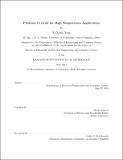| dc.contributor.advisor | Marin Soljačić. | en_US |
| dc.contributor.author | Yeng, Yi Xiang | en_US |
| dc.contributor.other | Massachusetts Institute of Technology. Department of Electrical Engineering and Computer Science. | en_US |
| dc.date.accessioned | 2015-01-20T15:30:56Z | |
| dc.date.available | 2015-01-20T15:30:56Z | |
| dc.date.copyright | 2014 | en_US |
| dc.date.issued | 2014 | en_US |
| dc.identifier.uri | http://hdl.handle.net/1721.1/92969 | |
| dc.description | Thesis: Ph. D., Massachusetts Institute of Technology, Department of Electrical Engineering and Computer Science, 2014. | en_US |
| dc.description | This electronic version was submitted by the student author. The certified thesis is available in the Institute Archives and Special Collections. | en_US |
| dc.description | Cataloged from student-submitted PDF version of thesis. | en_US |
| dc.description | Includes bibliographical references (pages 95-104). | en_US |
| dc.description.abstract | This thesis focuses on the design, optimization, fabrication, and experimental realization of metallic photonic crystals (MPhCs) for high temperature applications, for instance thermophotovoltaic (TPV) energy conversion and selective solar absorption. We begin with the exploration of refractory two-dimensional (2D) MPhC slabs as selective thermal emitters that approach the emittance of a blackbody below a cutoff wavelength, and zero emittance above the cutoff. The theory behind the enhancement of thermal emission is explored, leading to design handles that enable optimization for different applications. The fabrication process and extensive characterization of optimized 2D MPhCs are also presented. Next, we utilize non-linear global optimization tools to further optimize the 2D MPhCs for various TPV energy conversion systems. Performance estimates of realistic TPV systems incorporating experimentally demonstrated spectral control components are also presented. The numerical model is also used to pinpoint deficiencies in current TPV systems to uncover areas of future research to further improve system efficiencies. In particular, we show that air-filled 2D MPhCs suffer from decreased selective emission at larger polar angles, which can be circumvented by filling and coating the 2D MPhCs with a suitable refractory dielectric material. Finally, we explore PhC enhanced silicon (Si) photovoltaic cell based TPV systems numerically. Experiments towards record breaking efficiencies for Si cell based TPV systems are also presented and shown to agree well with numerical estimates, thus paving the way towards widespread adoption of what may be a promising highly efficient, portable, and reliable energy conversion system. | en_US |
| dc.description.statementofresponsibility | by Yi Xiang Yeng. | en_US |
| dc.format.extent | xxvii, 104 pages | en_US |
| dc.language.iso | eng | en_US |
| dc.publisher | Massachusetts Institute of Technology | en_US |
| dc.rights | M.I.T. theses are protected by copyright. They may be viewed from this source for any purpose, but reproduction or distribution in any format is prohibited without written permission. See provided URL for inquiries about permission. | en_US |
| dc.rights.uri | http://dspace.mit.edu/handle/1721.1/7582 | en_US |
| dc.subject | Electrical Engineering and Computer Science. | en_US |
| dc.title | Photonic crystals for high temperature applications | en_US |
| dc.type | Thesis | en_US |
| dc.description.degree | Ph. D. | en_US |
| dc.contributor.department | Massachusetts Institute of Technology. Department of Electrical Engineering and Computer Science | |
| dc.identifier.oclc | 900010547 | en_US |
